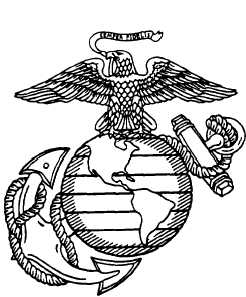| |
Figure 14-2.-Emblem of the U.S. Marine Corps.
Washington in 1801. It became known as “the
President’s own” during the early years of the
19th century, a title it holds today.
Back when marines wore leather stocks or
collars to protect themselves from the slash of an
enemy sword or cutlass, they were given the
nickname leatherneck. During World War I, after
the fourth Marine brigade distinguished itself
during action at Belleau Wood, the Germans were
said to have referred to the marines as
teufelshunden (devil dogs).
MARINE CORPS FUNCTION
The primary functions of the Marine Corps
are as follows:
To organize, train, equip, and provide
Fleet Marine Forces, together with
supporting air components, for service
with the Navy fleet in the seizure or defense
of advanced naval bases and for the con-
duct of such land operations as may be
essential to the prosecution of a naval
campaign
To provide detachments and organizations
for service on armed vessels of the Navy
To provide security detachments for the
protection of naval property at naval
stations and bases
To develop doctrines, tactics, techniques,
and equipment employed by landing forces
in amphibious operations
To develop the doctrines and procedures
for joint amphibious operations
The National Security Act of 1947 established
the roles and missions of the United States Marine
Corps. Today the Marine Corps stands ready to
carry out a wide variety of missions that higher
authority may assign. In addition to deploying
forces for amphibious operations, Marines train
foreign military forces and provide security for
diplomatic posts worldwide.
MARINE CORPS ORGANIZATION
The U.S. Marine Corps consists of not less
than three combat divisions and three aircraft
wings, and such land combat, aviation, and other
services as necessary to support them.
The Commandant of the Marine Corps
(CMC) is a Chief of Service and a permanent
member of the Joint Chiefs of Staff. The CMC
is responsible for the administration, discipline,
internal organization, training, efficiency,
readiness, and total performance of the Marine
Corps. The CMC also has responsibility for the
operation of the Marine Corps’ material support
system. When performing these functions, the
Commandant is responsible directly to the
Secretary of the Navy; the CMC is not a part of
the command structure of the Chief of Naval
Operations (CNO). A close cooperative
relationship exists, however, between the CNO,
as the senior military officer of the Department
of the Navy, and the CMC.
FLEET MARINE FORCE (FMF)
The Fleet Marine Force (FMF), which has
been in existence since 1933, comprises the main
fighting strength of Marines assigned to the
operating forces of the Navy. The FMF includes
all air and ground tactical units of the Marine
Corps. It is organized into two commands: Fleet
Marine Force Atlantic and Fleet Marine Force
Pacific.
The primary mission of the FMF is to conduct
overseas amphibious operations for the seizure
and defense of advanced bases as part of a naval
campaign. The nature of this mission, therefore,
requires that the FMF maintain a very high state
14-3
|

